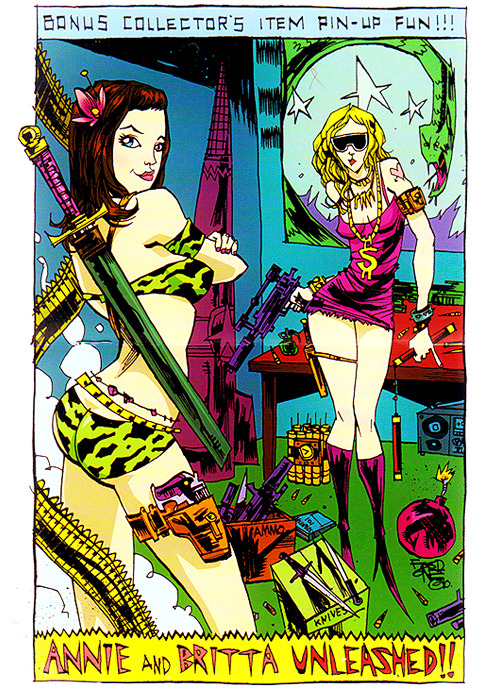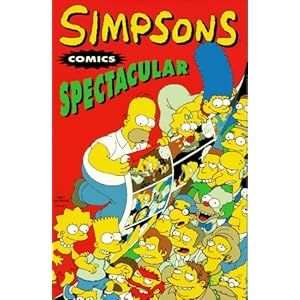
What if? Event Horizon
Writer: various
Artist: various
Published: Marvel, 2006
Yet another something I picked up on my recent trip to Vancouver!
Here is the What If? intro or the “wifntro”:
Alternate realities. What if Hitler hadn't gotten rejected from art school? What if JFK had never been assassinated? What if my father had become a bounty hunter instead of a teacher? What if I had been born a woman [it's what my mother wanted... *sob*]? These are all things that never came to pass. But what if there are parallel worlds in which events played out differently? What if we could access these other realities? The possibilities are pretty much infinite.

This is the basic concept of Marvel's “What If?” series. The writers meddle with events and the time line and see what happens. It's an interesting concept, similar to the alternate history books written by Harry Turtledove I see all the time at the bookstore.
These stories are often narrated by Uatu, who is a cosmic being known as a“Watcher”. The Watchers are essentially immortal and have devoted their lives to observing and recording history throughout the universe. He gives the reader the low down and provides them with the needed context for the short story. Which is something I should do right now, actually.

The First What If? is Deadly Genesis, a storyline in which it is revealed that Scott [“Cyclops”] and Alex [“Havok”] Summers have a younger brother called Vulcan. He is found by Moira MacTaggert, a close friend to Charles “Professor X” Xavier. She forms a team of her own “X-Men” and before they are finished training, they are sent on their first mission: rescue the original X-Men from an evil sentient island called “Krakoa”. Wow.
So this story deviates from the 1975 classic [and this is one of, if not THE defining comic of their entire catalog] by having the new X-Men live instead of dying like they did in the real continuity [you see, Xavier never tells Scott and Alex that his friend had discovered their younger brother and the new team was formed in secret, so they were clueless]. Scott, who has become a depressed and reclusive sculptor, is the only survivor of the original team. Basically, this changes the following: Vulcan was a villain in the real story, and he became the ruler of a alien race called “The Shi'ar” [don't ask] and began waging intergalactic war against a race called The Inhumans led by the immensely powerful Black Bolt [one of the Illuminati]. As you can see, this shit was pretty real. In the re-imagining, Vulcan stays on Earth and becomes the leader of the X-Men following Scott's downward spiral after Jean's death. His crazy-powerful powers are enough to subdue all of the X-Men's foes, the last naturally being Magneto, who rants and rages as he is led away in super-cuffs. Wild.
The thing is done as a flashback while we see Vulcan sitting on a couch, watching a DVD doc of himself entitled “The World's Greatest Superhero”. We learn all of the above up there. It's an effective way to tell the back-story. We then learn that some crazy shit went down on that island when the rescue mission was on and maybe this Vulcan really isn’t so different [no spoilers!] from his real [comic] version.
It's a real sweet twist on a pivotal moment in X-Men history and it's very well done. The art is nice and clean. I love the idea of Scott using his eye-lasers to sculpt images of his dead wife. Sculptclops!Another interesting change is that, thanks to Vulcan's popularity with the public, mutants aren't victims of discrimination like they are in the real reality. Also, I like Darwin's powers of “reactive evolution”. Basically, he evolves to survive any given situation, making him virtually unkillable. Very cool.
The story ends on a pretty depressing note, but I've always been a fan of downer-endings. I just find them more realistic than “happily ever after” bullshit.
One complaint: not enough Wolverine.

Up next we have an alternate take on the Avengers Disassembled storyline, which I'll admit, I am not terribly familiar with. Upon doing some research, it is still super-convoluted and pretty confusing. Here's the super-gist: Avenger Wanda “Scarlet Witch” Maximoff has basically gone insane due to her reality warping magical powers. She thinks the rest of the Avengers took her children away from her [her children were, in fact, magical constructs of her subconscious. Wacky!] She uses her magic to blow up half of the Avengers Mansion, killing several teammates in the process. She is finally stopped by Doctor Strange and her father, Magneto, takes her away to care for her.
So, where this story deviates from the original is that Captain America, himself suffering from brain-damage due to being frozen in a block of ice since 1945 [I'm glad they address this, as I imagine that would mess anybody up], has secretly allied himself with Scarlet Witch and seeks to use her reality warping to remake the world into a utopia. Hank “Beast” McCoy, being the super-intelligent gent that he is, senses something is amiss and, with Ms. Marvel acting as his Watson, he puts together the puzzle pieces. Hank gathers various Avengers and X-Men and finds Cap and Wanda at Magneto's island palace, where they do battle. In the ensuing brouhaha, mostly everyone is killed but Falcon and Iron Man are able to convince Cap that he is sick in the head, who in turn is able to talk sense into Wanda. They are grief stricken at what they have done and kill themselves. Big downer. Even bigger than the last.
I wasn't a huge fan. I like the twist of Cap being losing his mind, but the story didn't come together that cohesively. And when the climactic double-suicide goes down, it seems very rushed. I would expect more thought would go into such a decision. I didn't like the artist's take on Beast and the art overall was a bit too clean, lacking any real personality. Even Wolverine's increased presence cannot save this one.
I did enjoy the use of Ms. Marvel, as I have always considered her an under-used and under-developed character.

This one is probably my favourite of the bunch. SO MUCH WOLVERINE! A few years back, there was a storyline in which Wolverine is brainwashed by HYDRA [a terrorist organization] and becomes an assassin for them. In the real continuity, he gets deprogrammed and returns to his regular anti-hero self. This time around, he is not saved and goes on to slaughter much of the superhero community. In a series of flashbacks, he is shown killing/having killed: Spider-Man, Luke Cage, Moon Knight, some guy named Jean-Paul, Angel, Iron Man, Daredevil, Punisher, Black Panther, Thing and Spider-Woman. Holy shit!
So Captain America [who, by the way, has actually lost an arm and a leg in a previous fight with Wolvie] gathers whatever surviving heroes that he can in an attempt to lead his former friend into a trap. This small-yet- formidable group is made up of Kitty Pryde, Sue Storm and even Magneto! Naturally, their plan goes haywire and Wolvie wreaks some serious havoc, until he has cornered Kitty. She tries to talk sense into him, but he's not having it. In desperation, she pulls a crazy-sweet move that stops her former mentor.
Great story. This is Wolvie as the unstoppable killing machine he was meant to be. I've always been a fan of the “gruff father-figure” aspect of his persona, and this story puts a horrific twist on it. As Kitty pleads with him, he calls her “pup”, a mockery of what was once a term of endearment. The artwork has a certain grittiness to it. I like.

Following the possible best is the possible worst: an alternate version of Spider-Man's “The Other” story. The original features Spidey being overcome by his “spider” half [kinda lame] and makes himself a cocoon [pretty sure spiders don't do that?] under the Brooklyn Bridge, from which he emerges a changed man! He has now embraced his spider side and has amazing additions to his spectacular powers! Whatever. I think it's kind of lame to keep adding and changing the powers these heroes have. It happens way too often.
Anyway, in this one, Spidey rejects his spider side and remains inside his cocoon in a sort of limbo state, until the Venom symbiote escapes from super-jail and seeks him out. It bonds to him and over the space of a few months, destroys the mind of Peter Parker and possesses his body. Upon emerging, the creature seeks out Spidey's widow, who is staying at Stark Tower, in an attempt to remake her in his image. Wolverine and Luke Cage spring to her rescue, but ultimately it is MJ herself that defeats the creature with words [BORING!].
Bottom line: less talk, more Wolverine.
Hey! These stories are all super-bleak! Woo!

The next one is a new and "improved" take on the Age of Apocalypse story arc, which is itself an alternate reality! Jesus Christ! This is some Inception shit. Sometimes I think comic books have jumped the shark so hard that the Fonz is spinning in his grave. Anyway, the original AoA storyline has a very dear place in my heart, so I felt immediately drawn to this. The original plot has Professor Xavier's son travel back in time with the intention of killing the X-Men's arch-nemesis Magneto. Instead, he accidentally kills his father, who has yet to form the X-Men, when Xavier tries to defend his frenemy. This completely changes the course of history, allowing the ancient mutant Apocalypse to make his [largely successful] bid at overthrowing humanity.
This time around, the time-traveling troublemaker ends up killing his father and Magneto [who in main AoA continuity, is inspired by Xavier's death and forms his own X-Men to battle the tyrant], ensuring that there is absolutely no one to stop Apocalypse. The Watcher is back again and narrates what has happened at a breakneck speed. The pacing in this story is terrible. So much is glossed over so quickly, it gets irritating. The rise to power of Apocalypse would be interesting to see, yet we are given a scant 2 PANELS of that. Then, Scott and Jean, who are hiding in the Savage Land with their “child”, Nate, are surprised and killed by Apocalypse's minions [a lot of cameo's here] while their son is spirited away by Sauron. I had some problems with this scene. First, Nate is not actually the son of Scott and Jean. Rather he was grown from their DNA in a tube by Sinister. Second, Jean, one of the most powerful mutants in the world, is killed by a much less powerful foe in the corner of a tiny panel at the bottom of page two. What the hell?
Anyway, the fugitive Nate is found by Wolverine and taken to meet the resistance, led by a Mjölnir-weilding Captain America. The team includes Brother Voodoo, Captain Britain, Thing, Colossus and Molecule Man. This leads me to another couple of issues: Mjölnir grants its carrier the powers of the god, Thor [I know, I know], and Molecule Man has god-like powers. Shouldn't the combined efforts of these two be able to overthrow Apocalypse, who is merely somewhat god-like? And what have they been doing all this time?
You know, the more I think about it, the less I like this story. And this review is hella-long already. My apologies, but that is the nature of this beast. To try to end on a positive note, I did like the new roster of Horsemen: Juggernaut, Namor, Storm and, naturally, Hulk,
Oh, also, there was a good amount of Wolverine.
So, two out of the five stories actually impressed me. That's $4 out of the $10 purchase. Damn.
 The Horde
The Horde


























